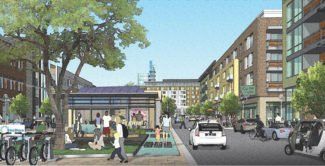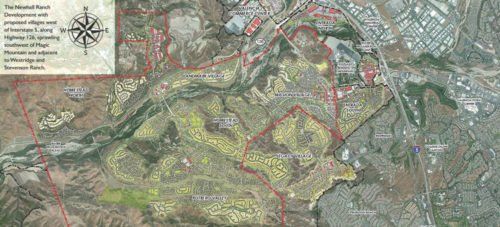Newhall Ranch: SCV Boon or Boondoggle?
This is a subtitle for your new post

Part 1: The Housing Crunch
First in a Series by Stephen K. Peeples
Imagine, if you will, a city with the population of Northridge dropped into the backyard of Stevenson Ranch, Six Flags Magic Mountain and Val Verde, and just over a ridge from the Chiquita Canyon Landfill.
But it’s no scene from “The Twilight Zone.”
That’s what’s about to happen, as a massive 21,500-unit mixed-use development called Newhall Ranch is built in the Santa Clarita Valley, along a six-mile stretch of open space off Highway 126 west of Interstate 5 in the northwest corner of unincorporated Los Angeles County.
Artist’s rendering of a Newhall Ranch community, courtesy of FivePoint Holdings.
With final county approvals in July 2016 and settlement of most pending litigation in September 2017, Orange County-based developer FivePoint Holdings started clearing brush, grading and laying out roads in October.
Build-out won’t happen overnight, of course. FivePoint predicts the first two Newhall Ranch phases, Landmark Village and Mission Village, totaling about 5,500 units, will hit the market in 2020.
But once the master-planned, 15,000-acre, 11 million-square-foot project is completed in 15-20 years, figuring three people to each of those 21,500 households, approximately 64,500 new residents will have moved to the development.
That means Newhall Ranch’s population would be greater than those of Northridge, Chatsworth, Azusa, La Crescenta, La Canada or many other communities or cities in L.A. County.
By any measure, 64,500 is a lot of new residents to add to the already large and fast-growing population in the Santa Clarita Valley, an estimated 293,042 residents as of 2016, according to the latest stats from the nonprofit SCV Economic Development Corporation. [http://www.scvedc.org/datacenter/scv-demographics/]
That included the 219,611 people who resided within the city of Santa Clarita, now the largest city within the SCV (and the third largest of L.A. County’s 88 incorporated cities, after Los Angeles and Long Beach). Newhall Ranch is a stone’s throw from the city’s northwestern border.
Population growth in the SCV has been more than three times the state- wide rate just in the past 15 years (up 41 percent compared to 14 percent). In Part 1 of Wealth | Wisdom | Wellness’ series previewing Newhall Ranch, we’re taking a closer look at the SCV’s growing population and the local-regional housing crunch.
In future editions, we’ll look into how the development and its new residents may affect the SCV employment picture, the valley’s infrastructure, vehicle traffic, water supplies and the natural environment. We’ll also look at fire danger in the Newhall Ranch area, which was scorched in the Rye Fire in early December.
Newhall Ranch – The Promise
As has been extensively documented by Santa Clarita Valley and Southern California media over three decades-plus, Newhall Ranch was first proposed during the 1980s housing development boom, but delayed by lawsuits and investigations until 2017.
Now, in the development’s latest state, county and tribes-approved iteration, FivePoint Holdings promises the 21,500 new housing units will help ease the local-regional shortage of homes. Newhall Ranch will also provide 120,000-130,000 jobs during buildout (many in construction) and ultimately up to 60,000 permanent jobs, FivePoint predicts.
“Even with the best projections and environmental impact reports and mitigations agreed to by FivePoint, county and state officials, and the California Supreme Court, not everyone who resides in the Santa Clarita Valley is convinced Newhall Ranch is a good idea.”
The developer has promised the project will not disrupt historic indigenous peoples sites, harm endangered species, or pollute the water in the adjacent Santa Clara River owing downstream west through Ventura County to the ocean.
FivePoint assures Newhall Ranch will have a net-zero impact on adding greenhouse gas to the natural environment. Homes will generate their own clean energy via solar systems, and each home will be equipped with an electric car charging station.
FivePoint promises additional off-site GHG mitigation to zero out the entire Newhall Ranch development, via installing charging stations in other California locations, contributing clean-burning cook stoves to people in remote areas of Africa, and paying for forest preservation in other parts of the world.
New, Existing and Semi-Affordable Homes
Obviously, the true impact of Newhall Ranch and its population on the SCV will take years to play out.
Today, though, the improving economy and aforementioned shortage of existing homes is putting upward pressure on purchase prices and rents. It’s also fueling purchases of new homes when and where buyers can’t find or afford an existing home. Since housing prices are rising faster than most people’s income, that crunch is not likely to ease anytime soon.
L.A. County needs to build approximately 180,000 new housing units between now and 2021 to keep up with the area’s population growth and keep home prices from spiking even higher, according to the Southern California Association of Governments, the largest urban planning organization in the country.
But home building in L.A. County, especially affordable housing, is actually moving at a much slower pace.
“In the last five years, only 1,200 residential units were developed in unincorporated Los Angeles County,” Hasan Ikhrata, SCAG’s executive director, told The Los Angeles Times (Sept. 25, 2017). [http://www.latimes.com/local/lanow/la-me-newhall-ranch-20170925-story.html]
“And a person has to earn $106,000 a year in order to afford a home in the region, where the median price is currently $600,000,” Ikhrata said.
Right now, a FivePoint single-family home in nearby West Hills-Valencia or Stevenson Ranch, considered upscale neighborhoods in the SCV, starts in the high $500K range.
FivePoint is projecting homes in mixed-use Newhall Ranch to range from $300K for a condo to $1 million for a home, according to the L.A. Daily News (Dec. 3, 2017). [https://www.dailynews.com/2017/12/03/work-begins-on-21500-home-project-with-ambitious-goals-to-combat-climate-change/]
That would put the median cost of a new home in Newhall Ranch between $600K-$700K, which may be beyond the budget for many Santa Clarita Valley residents.
While a third of wage-earners make more than $125,000 a year, median household income in the SCV (i.e., all wage earners in a household) is $95,064, according to the latest figures from the SCVEDC. [http://www.scvedc.org/datacenter/scv-demographics/] That’s $11K less than the income SCAG says is adequate.
The Need for Quality Jobs
Then who will be qualified to buy those 21,500 Newhall Ranch homes?
Obviously, only people who already have quality jobs with $100K-plus salaries – or households in that range with more than one income earner – can afford a $600K-plus mortgage.
Of the 60,000 permanent jobs promised, how many will be quality jobs with salaries high enough to pay a mortgage? For a Newhall Ranch home?
Based on local housing costs, median income, and employment opportunities, the people who buy Newhall Ranch homes will most likely move there from areas outside the SCV, and continue to commute to their existing jobs.
With 21,500 homes and figuring two working adults per household, that could mean as many as 43,000 new freeway commuters. They would add to the already nightmarish traffic jams on Interstate 5 of workers headed south to those quality jobs at innovation centers like Burbank-Glendale-Pasadena, Hollywood, Downtown L.A., Century City-Westwood-Beverly Hills, Santa Monica, and Playa Vista/LAX.
“So, in addition to supplying homes,” SCAG’s Hasan Ikhrata told The Times, “we must combat the congestion problems along Interstate 5, in part by creating enough jobs in the north county areas so that people don’t have to commute.”
Do those jobs exist in the SCV now, or will they exist by the time the first Newhall Ranch homes hit the market a couple years from now?
“Based on local housing costs, median income, and employment opportunities, the people who buy Newhall Ranch homes will most likely move there from areas outside the SCV, and continue to commute to their existing jobs.”
Major corporations with a clear vision of the future are relocating to innovation centers with large, talented and skilled Millennial workforces.
Does the SCV have a Millennial workforce that can compete with the innovation centers over the hill? Can the area compete with Playa Vista, now emerging as a new “Silicon Beach” by attracting companies like Google and Yahoo?
Or will the SCV be able to develop a Millennial workforce by the time all those 64,500 additional Newhall Ranch residents move to the valley?
We’ll hear the voices of several sides in Part 2 of our series, as we take a closer look at how Newhall Ranch may affect the SCV employment picture and the commute. Stay tuned.
Wealth Wisdom Wellness is published by CT3Media, Inc.
© Wealth | Wisdom | Wellness Magazine. All Rights Reserved.
ABOUT US
Wealth | Wisdom | Wellness is published by CT3Media, Inc.
© Wealth | Wisdom | Wellness Magazine. All Rights Reserved.





